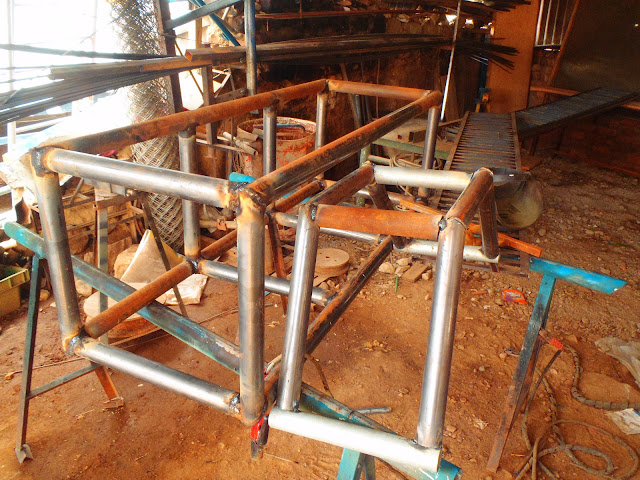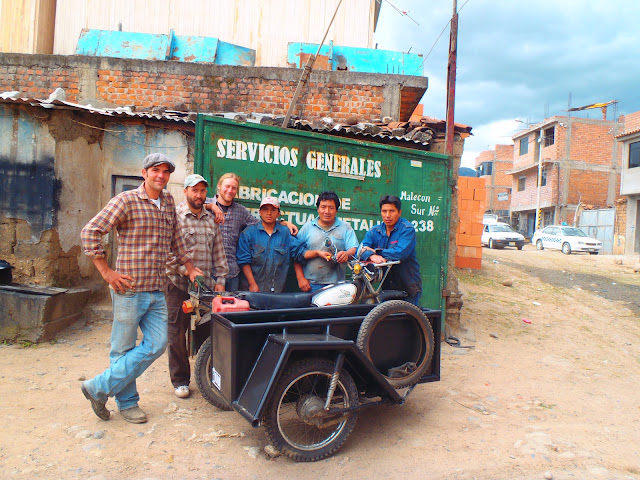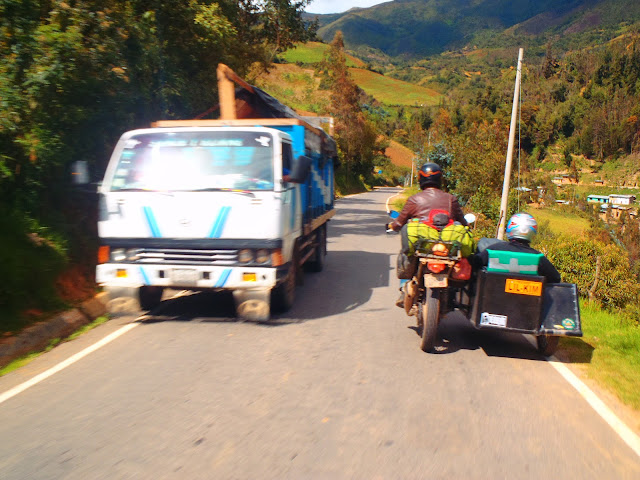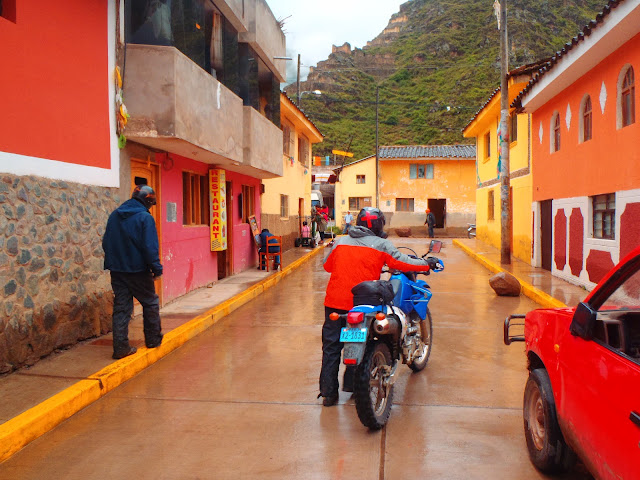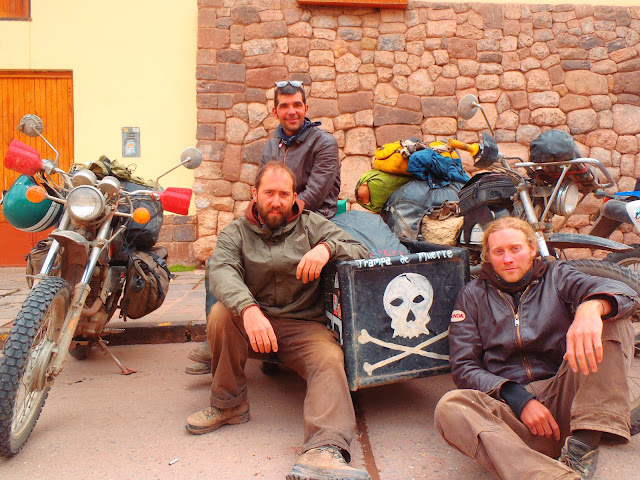M.F. Escher's sidecar design, the beginning.
Pulling the throttle, we make it to Huarez, Peru a couple days before Hoge's (hoe-ga) arrival from his visit to Venezuela. This gives us time to recover a little from the tough dirt roads of northern Peru and scope out some welding shops from what will come to be a wonderfully bad idea stemming from trying to figure out how all three of us can hang out together. Hoge has 20 days. We have loaded bikes, and renting a car is expensive and leaves our bikes behind. Also, if Hoge takes a bus somewhere, there are no guarantees that we can catch up with him. The only logical conclusion that comes to us is to build a sidecar.Scouring the city surrounded by towering mountains, we find a welding shop that could do the job. The owner haphazardly agrees to the idea and tells us to return later. Finding a rear wheel set from a small mid1960's Honda in a pile of junk, we buy it and rip it out. Now, we are officially committed. Our goal is to build the rig spending no more than $300.
Getting the South American run around, we wait and wait for days. Finally, the owner sends a worker to us. He looks at the hand drawn diagram and turns into a deer in headlights, frozen in confusion. The owner comes over, looks at the design and sends us off within seconds saying it will take too much time. The worker jumps on a bike and leads us to someone that can help. We arrive, and its a bicycle mechanic. He throws up his hands and zooms off. Back to the beginning, we search for welders.
In the dirty market district, we ask and ask with some funny looks to the idea of which they've never seen. We eventually find a guy that wheels out his wheelchair to our project. He says he can do it, along with some other things that let us know that he doesn't know what he's getting into. However, he calls a guy that strolls down the way and quietly accepts the job.
This is the alley of the market where dreams are made. Below is Hoge after being accosted by a transvestite telling him he needed to pay for the outhouse he was using, while he was using it.
The guys get started right away and have the box built before we know it.
Getting started is the tough part. In Spanish, we have to get our idea across, explain technical specifications of angling the motorcycle as well as the 3rd wheel, and figure out how to work together through the project. This is part of the explanation, a drawing on the dirt floor of the shop's office.
The night sky fills with color like our days fill with anticipation for an adventure of the total unknown -- Huarez to Cusco through the mountainous backroads with a handbuilt sidecar.
There are three attachment points...
...a new tire...
...and the perfect level of the dirt workshop to align the angles.
The shop's surroundings
What could go wrong?
After 2 days, the skeleton test drive is a success.
Accustomed to a culture where "on time" doesn't exist, we show up slowly the next morning and there she is, paneled and painted.
Sharp.
Mike took the guys for a head-turning spin. They were pumped.
And here we are, ready.
Something from nothing...the team.
All the heads turn, and it never stops.
After an epic celebratory evening, we departed...
...and it was extremely rough.Skipping the test drive, we stopped at the riverside to check out the rig, and Hoge got in the river of snow runoff.
Nothing cures a tough morning better than a motorcycle ride through a crisp clear day.
It is amazing to have our good friend visit and become part of our trip to see how it really is. Hoge adds a LOT of flavor.
We start climbing.
The escape pod.
Temperature differences are drastic throughout just one day.
Driving the sidecar is fine on the straights, but the turns create the phrase "wrestling the bear".
In many regions, its difficult to find gasoline. The search often leads you to someone's house, and the sidecar then leads you to some funny interactions.
Some interactions are not so fun. From the moment we left the United States we have been attacked by every dog along our path. They hate single cylinder motos, and now we hate them.
We draw more attention than we ever imagined. It is non-stop and overwhelming. We call the sidecar the Pope Mobile, for the rider must wave to every person.
We dubbed the sidecar "Trampa de Muerte as well, the "Death Trap". Quite often the small roads don't leave too much room on the road.
Skull and crossbones, "so that people will know what we're up to", says Hoge.
The elevation bounces up and down rather quickly. Above is the morning and early afternoon...
...and this is later in the same afternoon. During the beautiful part of the day, Mike lets me drive the Death Trap for the first time, my first time driving any sidecar. The weather turned to this on my first run.
Hail the size of peas, perfect for the open face helmets.
I don't know one person that could handle such conditions with such humor and style.
...yeah, I don't know either.
All smiles at the worst hotel of the run.
One of the front brake pads fell off.
We fixed it. Hoge kept pretty busy.
No comment.
So after a couple close calls and a lot of dirt roads, we make it to Pampas, a surprisingly nice little town in the middle of nothing. We spend the night, and in the morning the 250 does not start. This blossoms into a slew of problems. Basically, my bike has been slowly falling apart, and on this morning it all collapsed at the same time. This coming week, my bike presents more problems than it has had in the entire trip combined. This is how I felt about it when we got it running long enough to get 10km away from town and the crowd of locals that stared at our efforts.
Our efforts at first causes the locals to offer advice of this and that as well as the location of the closest mechanic to our uninterested ears until the repairs get into the alien looking wiring diagrams. Then, the crowd grows silent.
Making it just a little down the road before things hit the fan again, we return to town and find a parts shop run by these girls. The gathered crowd loved Mike's sideways sliding entrance. One of them takes Mike on a ride for his first time in the sidecar. She pulled into traffic without stopping causing horns to blare from the swerving tuk tuk mototaxis. He survives to ride another day.
Old ruins remain on the sides of mountains whispering of times passed.
I had quite the moment just before this picture was taken. I was off my bike when a llama came up to me with a sideways look I didn't trust. Not really knowing how a llama would attack, I just stood there choosing to trust him. He walked on passed and didn't even spit on me.
If you've ever wondered what a Peruvian ghost town looks like, here you go. With a broken compass that only points south and maps that don't show it all, we trust in the one man that was found walking aimlessly in the empty village.
Every once in a while there is a paved road, and its a nice break.
Popping out into a town, almost a city, is a nice relief. Access to internet and at least one alternative on the menu is a treat. However, having more than one road to choose from in an unmarked, poorly designed urban area with rough maps can be difficult, so a police escort comes in very handy.
Roadside breaks are on a different level though. Mountain streams, waterfalls, and llama herders are normal.
Traveling by bike is one of the greatest ways to travel. You can stop whenever you feel, and do whatever you want. I'm not sure if I can travel any other way.
Though, sometimes it gets really cold and you have to stop to hide behind a sign to get out of the wind.
One is never really alone, even if you are very far away. There will almost always at least be a shepherd, and his sheep and llamas.
Yarrr
Tank is eaten by curiosity in this village, never to be seen again.
Smiles and sunburned cheeks.
In the States you stop for chips and a soda, in Peru you get this.
Eventually, after much dirt road torture to the Pope Mobile it finally broke. One of the attachments broke loose and slid down breaking the weld from the support arm to the car causing the Death Trap to nose dive (no wreck mom). The welder had used a cut-off part of his leather glove as a spacer that had gotten wet. We're still not sure why it wasn't welded. However, it leads us into one of the most epic parts of the entire trip.
Surrounded by gigantic mountains and clouds as well as the occasional sheep, and llama, Hoge shoulders his huge backpack and starts walking. We creep to the next village that we hope is there, and that we hope has a welder...a lot to ask for in a moment such as this. In a round about way we find a clue of the one man that might be able to help us. He lives in a cluster of a few houses tucked onto the side of a mountain. Finding him creates a huge scene of curious old timers and extremely excited kids. Hoge finds us after acquiring the respect of the locals by carrying a load such as theirs through the high elevation mountains. The welder agrees to help us, and a lady pulls out a couple sheep skins for us to sit on. Hoge and I grab a flat soccer ball and take on the village kids. Its about 20 to 2, but we hold our ground til we start tasting blood from running around at 15,000ft.
Where's Tank? Surrounded.
If you're wondering how many people we can fit into our sidecar...
Night falls as the work is completed. Upon asking us about sleeping arrangements and food, they find we have tents and no food. The welder offers us his workshop. We accept and are elated. He sweeps the sawdust aside and brings us a tarp. Feeling well treated, we are highly surprised by his next move. He brings us a huge stack of thick sheep skins on which to lay. Blowing us away, he again returns with heavy alpaca blankets. This sort of kindness is rarely found, but then again, how often does one leave himself this vulnerable. However, what comes next is to our greatest surprise.
As we sit on the blankets and skins, the gathered crowd parts for a stooped old lady carrying a pot, bowls with spoons, and a pile of potatoes. Our hunger rages, and she places the potatoes before us. She begins pouring out a broth soup. Like the sidecar, Mike and I's hunger nose dives as a ball of something splats into one of the bowls. Hoge has no clue what is coming. With her unwashed hands, she rips apart the best of what she has into thirds and hands us the bowls. We are the only ones eating, and with the whole village watching, including the proud cook, we hold in our hands our meal...sheep intestine soup.
We take their advice of eating it before it gets cold and hold a pleasant conversation with forced smiles and incredible control of holding back the intense reflex to gag. We hide our arguing in English with Hoge to eat his portion, but he refuses saying its even more rude to puke on their sheep skins. Mike steps up to the plate and eats some bites of his till something like a blue vein falls out. While one of us fights the food, the others are communicating with the group that only speaks maybe 20% Spanish and the rest some dialect of Quechua, the indigenous Incan language.
This lady is the proud cook, watching our every bite. They truly have given us all they had, and it is one of the best moments of the trip, one that could never be bought. We stay up a long time this night laughing as the rain falls and eventually turns into snow.
Of course the bikes don't want to work in the morning's freeze and causes what would be the awkward exaggerated goodbye if we weren't used to it by now.
But how much more epic does it get than more than one man in a cape?
Never ask someone like this for directions, ever.
After getting my bike going from the last critical failure, we get her down the road for a couple of days. Unfortunately, it is in the wrong direction. We had passed up what we came to find out is an extremely obscure turn and end up going northeast. And in our lost condition, my bike breaks down again. With hours of work, we figure out that there is a short in the wiring system, so we unplug everything, lights and all. It works to get the bike going, and on the test drive lightning strikes twice. The front sprocket spins the teeth off of the output shaft. The engine now runs great, but cannot spin the wheels = useless.Sorry Mother Earth.
Trying many things to get her up the mountain, nothing works. Hoge and I have to push her, and at 15,000ft, it ain't easy.
We luckily find a welder, but he's drunk, so we arrange to work tomorrow. After a short, sunburned eternity, we track down the owner of the one hotel so we can get a room. We pay about $2 for all three of us to stay in the only room they had (if that tells you how high class it is). In the courtyard, we rip open the engine and pull out the output shaft which is buried inside the transmission.
An earthquake in the night cuts the electricity and delays our start in the morning. Mike came up with the idea to weld knobs of metal onto the shaft and then file it to form.
Magically, it worked.
We take off from our solved dilemmas and make our way back to the turn off we had missed days before. We climb up and over a mountain pass, crossing into a warm dry desert. Coupled with escaping the Peruvian Triangle, it is a dream come true. We are on the right path.
So on these back roads, we figure its a good time for Hoge to learn to ride a motorcycle. He starts with the sidecar. Its tough to drive, but at least you don't fall over while learning the gears. He does good. In fact, he takes off, fast. It seems like a good time to practice my surfing.
Once figuring out the clutch, he graduates up to the Escape Pod. He loves it as we bomb around some highland rolling mountains. On a high mountain pass, with only the occasional llama anywhere around, we come across something before unseen. We pull up and are waved down by two cops. One is holding a video camera and has been recording our approach. He does not budge from the law that states that one must have a headlight at all times. We had previously unplugged all my wiring to fix whatever the problem had been. Right there, he gave us a ticket, the first and only of our year long trip.
And then the side car breaks again. The next town is all the way down the mountain, it can be seen. Too dangerous to risk someone in the Pope Mobile, I choose to walk this time. They take off down the huge switchbacks to get started on another welding mission.
Meanwhile, I look at the miles of switches and then at the direct route down the mountain. Not scared of a little off-trail meandering, I jump off the road and work my way through cacti and tall brush, scramble down avalanched washes, and see in the distance two figures. I whistle and they return the call. I work my way to them. There is a man and a kid. The man is shouldering a rifle, and the kid holds a long walking stick. After greeting, we walk silently along the mountainside. We do not follow any trail as they continue in their hunt for their dinner. At an overlook, they point out the direction that leads to a footpath which will take me to town. We part.
Along the footpath, I bound down to surprise some potato farmers who are returning from the fields. The youngest girl carries a huge amount of potatoes on her back, and they all wear rubber sandals made from tires. Their feet look tougher than my boots.
I make it to town to the surprise of the people. However, I get it in return when I see the buckets of guinea pigs and oinkers being washed.
At somewhere around 13,000 miles of the trip from Tennessee to Peru, my gauges finally give out. Mike's had never worked.
This guy fixes us up in the falling rain. That seems dangerous to us as all his exposed wires lay in puddles.
Now on a roll with time becoming short, we make it close to Cusco. However there is one stop before we get there, the famous Machu Picchu. We have two days before Hoge has to fly back to Lima to catch his plane for the States. Being so close to Cusco, we turn off and head northwest to visit the famous ruins. Asking locals, they tell us it is close, maybe an hour. To us, that means at least two. So we drive.
Further and further we head up into the mountains. We pass the town of Ollantaytambo where we feel we should stay, but by now, Machu Picchu should be very close. We continue up the mountain. Up and up we ascend as the night encroaches. Bombing down the mountain the other way, an unloaded motorcyclist signals us to turn around. When he pulls off his helmet we realize that its Nate, one of our photojournalist friends we made in Colombia and met again in Huarez at the start of this sidecar mission. His bike had broken and he has rented a moto to run to the ruins.
Contrary to the thoughts of the locals, he tells us that from where we are, we still must cross over a monstrous pass covered in snow till it turns to a long stretch of dirt that will lead to a small town. From that town, we must find a place to store the bikes and catch a bus or train to the next town. From there we must then catch another bus or hike up to the ruins, visit, then do it all in reverse. The very quickest we could achieve this is in 3 days. Above is the photo of that realization. We are at the gateway to the famous ruins and we cannot get in. Accepting our fate, we turn and return to Ollantaytambo to spend the night.
In the morning, it is actually Nate's rental bike that refuses to start. It takes us hours to get it going, mainly due to the lack of specific tools needed for that machine. Eventually we get down the road.
And by God, we made it....CUSCO.
We checked into a fancy hotel for the night and relaxed the next day. Then Hoge departed.
On the computer, the route we were supposed to go with more paved roads and the way everyone wanted to direct us should have taken 17 hours. It took us 2 weeks. We loved every bit of it.










